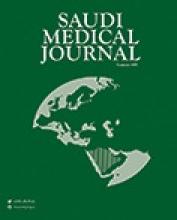Abstract
OBJECTIVE: To evaluate the changes in pulmonary volumes during and after Islamic fasting.
METHODS: It is a cohort study conducted on 117 healthy subjects selected on a random basis from employees, professors and students of Iran University of Medical Sciences, Tehran, Iran, between December 1999 and January 2000. All of them underwent spirometry 10 days prior to Ramadan, 2 times during Ramadan, and one time 10 days post-Ramadan. In first visit, in addition to spirometry they underwent medical examination to make sure they are healthy. All of their spirometries and background information were collected. Repeated measurements analysis of varience method was used to compare the measurements.
RESULTS: Approximately 69% of subjects were male and the mean age was 23.9 years. Mean fasting time was 27.8 days. The mean difference in forced expiratory volume in 1 second (FEV1%) was significant between the 4 visits (p=0.01). The mean FEV1% increased both during fasting and after Ramadan (p=0.017). The mean vital capacity and peak expiratory flow rate values increased during Ramadan significantly (p=0.043, p<0.001). Although the mean maximum mid-expiratory flow decreased in the beginning of Ramadan and significantly increased subsequently (p=0.02), MEF50% (p=0.004) and MEF75% (p=0.047) increased in the beginning of Ramadan and decreased subsequently.
CONCLUSION: As a whole, fasting increases lung volumes and might improve pulmonary function. This finding seems to be relevant to the changes in weight during Ramadan.
- Copyright: © Saudi Medical Journal
This is an open-access article distributed under the terms of the Creative Commons Attribution-Noncommercial-Share Alike 3.0 Unported, which permits unrestricted use, distribution, and reproduction in any medium, provided the original work is properly cited.






